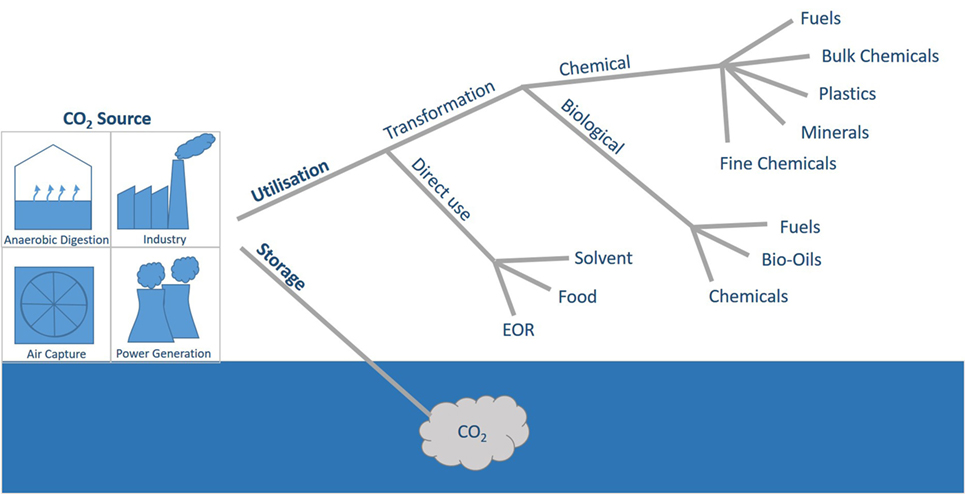Biodiversity & Environment
CCUS Policy Framework and its Deployment
- 30 Nov 2022
- 5 min read
For Prelims: CCUS Technologies, Paris Agreement.
For Mains: CCUS Technologies, Applications, Net Zero emissions by 2050, Environment Degradation, Conservation.
Why in News?
Recently, NITI Aayog has released a study report, titled ‘Carbon Capture, Utilisation, and Storage (CCUS) Policy Framework and its Deployment Mechanism in India’.
- The report explores the importance of Carbon Capture, Utilisation, and Storage as an emission reduction strategy to achieve deep decarbonization from the hard-to-abate sectors.
What are the Key Highlights of the Report?
- About:
- CCUS can provide a wide variety of opportunities to convert the captured CO2 to different value-added products like green urea, food and beverage form application, building materials, chemicals (methanol and ethanol), polymers (including bio-plastics) and enhanced oil recovery (EOR) with wide market opportunities in India, thus contributing substantially to a circular economy.
- CCUS projects will also lead to a significant employment generation. It estimates that about 750 mtpa of carbon capture by 2050 can create employment opportunities of about 8-10 million on full time equivalent (FTE) basis in a phased manner.
- Suggestions:
- Broad level policy interventions needed across various sectors for its application.
- As, India has updated its NDC targets for achieving 50% of its total installed capacity from non-fossil-based energy sources, 45% reduction in emission intensity by 2030 and taking steps towards achieving Net Zero by 2070, the role of CCUS becomes important as reduction strategy to achieve decarbonization from the hard-to abate sectors.
- India’s dependency on fossil-based Energy Resources is likely to continue in future, hence CCUS policy in Indian Context is needed.
What is Carbon Capture, Utilization, and Storage?
- CCUS encompasses methods and technologies to remove CO2 from the flue gas and from the atmosphere, followed by recycling the CO2 for utilization and determining safe and permanent storage options.
- CO2 captured using CCUS technologies is converted into fuel (methane and methanol), refrigerants and building materials.
- CCUS is considered an important tool to help countries halve their emissions by 2030 and reach net-zero by 2050.
- These goals are crucial to meet the Paris Agreement targets for restricting global warming to 2 degrees Celsius (°C), and preferable to 1.5°C, over pre-industrial levels.
What are Applications of CCUS?
- Mitigating Climate Change: Despite the adoption of alternative energy sources and energy efficient systems to reduce the rate of CO2 emissions, the cumulative amount of CO2 in the atmosphere needs to be reduced to limit the detrimental impacts of climate change.
- Agriculture: Capturing CO2 from biogenic sources such as plants and soil to boost crop growth in a greenhouse could work.
- Industrial Use: Combining CO2 with steel slag - an industrial byproduct of the steel manufacturing process — to make construction materials compatible with the Paris Agreement goals.
- Enhanced Oil Recovery: CCU is already making inroads into India. For instance, Oil and Natural Gas Corporation signed a MoU with Indian Oil Corporation Limited (IOCL) for Enhanced Oil Recovery (EOR) by injecting CO2.
What are the Challenges associated with CCUS?
- Expensive: Carbon capture involves the development of sorbents that can effectively bind to the CO2 present in flue gas or the atmosphere, which is expensive.
- Lesser Demand for Recycled CO2: Converting CO2 into useful chemicals of commercial importance, or utilizing CO2 for oil extraction or remediation of alkaline industrial wastes, would add economic value to this greenhouse gas.
- However, the demand for CO2 is limited compared to the vast amount of CO
2that needs to be removed from the atmosphere, to reduce the detrimental environmental impacts of climate change.
- However, the demand for CO2 is limited compared to the vast amount of CO
Way Forward
- Any viable system for storing carbon must be effective and cost competitive, stable as long-term storage, and environmentally benign.
- Countries should narrow down on the handful of technologies that show more promise and channel investment in them.
- Replacing a conventional fuel with a synthetic fuel like methanol produced via CCU is likely to be a successful mitigation strategy only if clean energy is used to capture CO2 and convert it into synthetic fuel.





